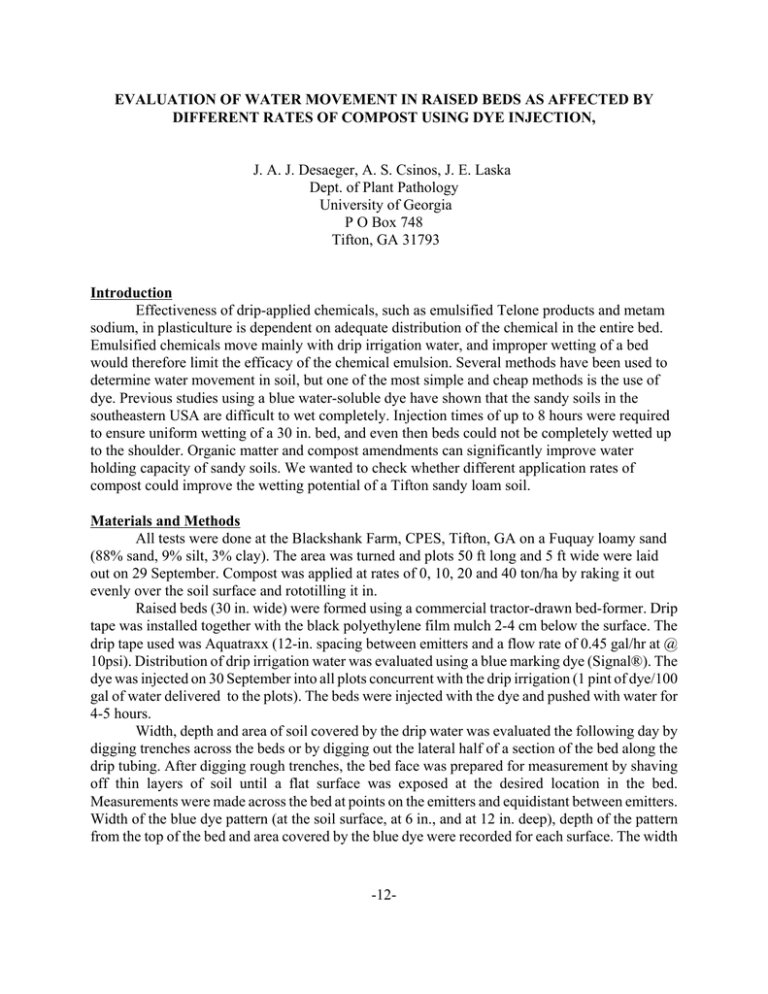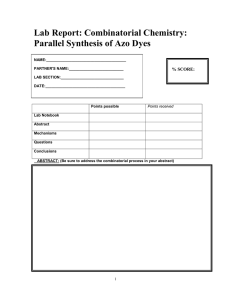EVALUATION OF WATER MOVEMENT IN RAISED BEDS AS AFFECTED BY
advertisement

EVALUATION OF WATER MOVEMENT IN RAISED BEDS AS AFFECTED BY DIFFERENT RATES OF COMPOST USING DYE INJECTION, J. A. J. Desaeger, A. S. Csinos, J. E. Laska Dept. of Plant Pathology University of Georgia P O Box 748 Tifton, GA 31793 Introduction Effectiveness of drip-applied chemicals, such as emulsified Telone products and metam sodium, in plasticulture is dependent on adequate distribution of the chemical in the entire bed. Emulsified chemicals move mainly with drip irrigation water, and improper wetting of a bed would therefore limit the efficacy of the chemical emulsion. Several methods have been used to determine water movement in soil, but one of the most simple and cheap methods is the use of dye. Previous studies using a blue water-soluble dye have shown that the sandy soils in the southeastern USA are difficult to wet completely. Injection times of up to 8 hours were required to ensure uniform wetting of a 30 in. bed, and even then beds could not be completely wetted up to the shoulder. Organic matter and compost amendments can significantly improve water holding capacity of sandy soils. We wanted to check whether different application rates of compost could improve the wetting potential of a Tifton sandy loam soil. Materials and Methods All tests were done at the Blackshank Farm, CPES, Tifton, GA on a Fuquay loamy sand (88% sand, 9% silt, 3% clay). The area was turned and plots 50 ft long and 5 ft wide were laid out on 29 September. Compost was applied at rates of 0, 10, 20 and 40 ton/ha by raking it out evenly over the soil surface and rototilling it in. Raised beds (30 in. wide) were formed using a commercial tractor-drawn bed-former. Drip tape was installed together with the black polyethylene film mulch 2-4 cm below the surface. The drip tape used was Aquatraxx (12-in. spacing between emitters and a flow rate of 0.45 gal/hr at @ 10psi). Distribution of drip irrigation water was evaluated using a blue marking dye (Signal®). The dye was injected on 30 September into all plots concurrent with the drip irrigation (1 pint of dye/100 gal of water delivered to the plots). The beds were injected with the dye and pushed with water for 4-5 hours. Width, depth and area of soil covered by the drip water was evaluated the following day by digging trenches across the beds or by digging out the lateral half of a section of the bed along the drip tubing. After digging rough trenches, the bed face was prepared for measurement by shaving off thin layers of soil until a flat surface was exposed at the desired location in the bed. Measurements were made across the bed at points on the emitters and equidistant between emitters. Width of the blue dye pattern (at the soil surface, at 6 in., and at 12 in. deep), depth of the pattern from the top of the bed and area covered by the blue dye were recorded for each surface. The width -12- of the dye pattern was measured with a ruler, and the dye-covered area with a 24 in. by 24 in. grid etched in plexiglass by counting all grid squares in which half or more of the square was blue. Data are means of four replications of measurements per bed. Means followed by the same letter are not significantly different (P = 0.05) according to Duncan’s multiple range test. Summary Compost applications had little effect on water movement. When measured on emitters, dye patterns at the soil surface were wider in the non-compost-amended plots. However, at depths of 6 and 12 in., especially when measured between emitters, water movement in noncompost-amended plots was significantly less than for the 10 ton/ha compost application (Table 1). Higher compost application rates resulted in dye patterns somewhere in between. The total area covered by dye was not significantly different, but was numerically lower in non-compostamended plots when measured between emitters. Probably, to significantly improve water movement in sandy soils of the coastal plains, repeated compost amendments are required. Acknowledgments The authors wish to thank Chris Williamson, Tonya Jo Cravens, Unessee Hargett and Don Hickey for technical support. -13- Table 1. Width of dye pattern and total dye coverage area of cutaway face of plastic covered beds, influenced by different compost application rates, 29 September, 2003. Compost rate Width of dye pattern (inches) at different soil depth On Emitter Dye coverage (square inches) Between Emitter On Emitter Between Emitter 0 in. 6 in. 12 in. 0 in. 6 in. 12 in. 0 25.3 a 20.0 17.0 23.8 a 15.0 b 13.3 b 286 247 10 19.0 b 21.0 21.3 18.0 b 17.5 ab 21.0 a 275 262 20 22.0 ab 19.8 17.0 22.8 ab 20.0 a 17.3 ab 283 268 40 22.0 ab 19.0 20.0 20.8 ab 16.8 ab 17.8 ab 278 260 Data are means of four replications of measurements per bed. Means followed by the same letter are not significantly different (P = 0.05) according to Duncan’s multiple range test. -14-




